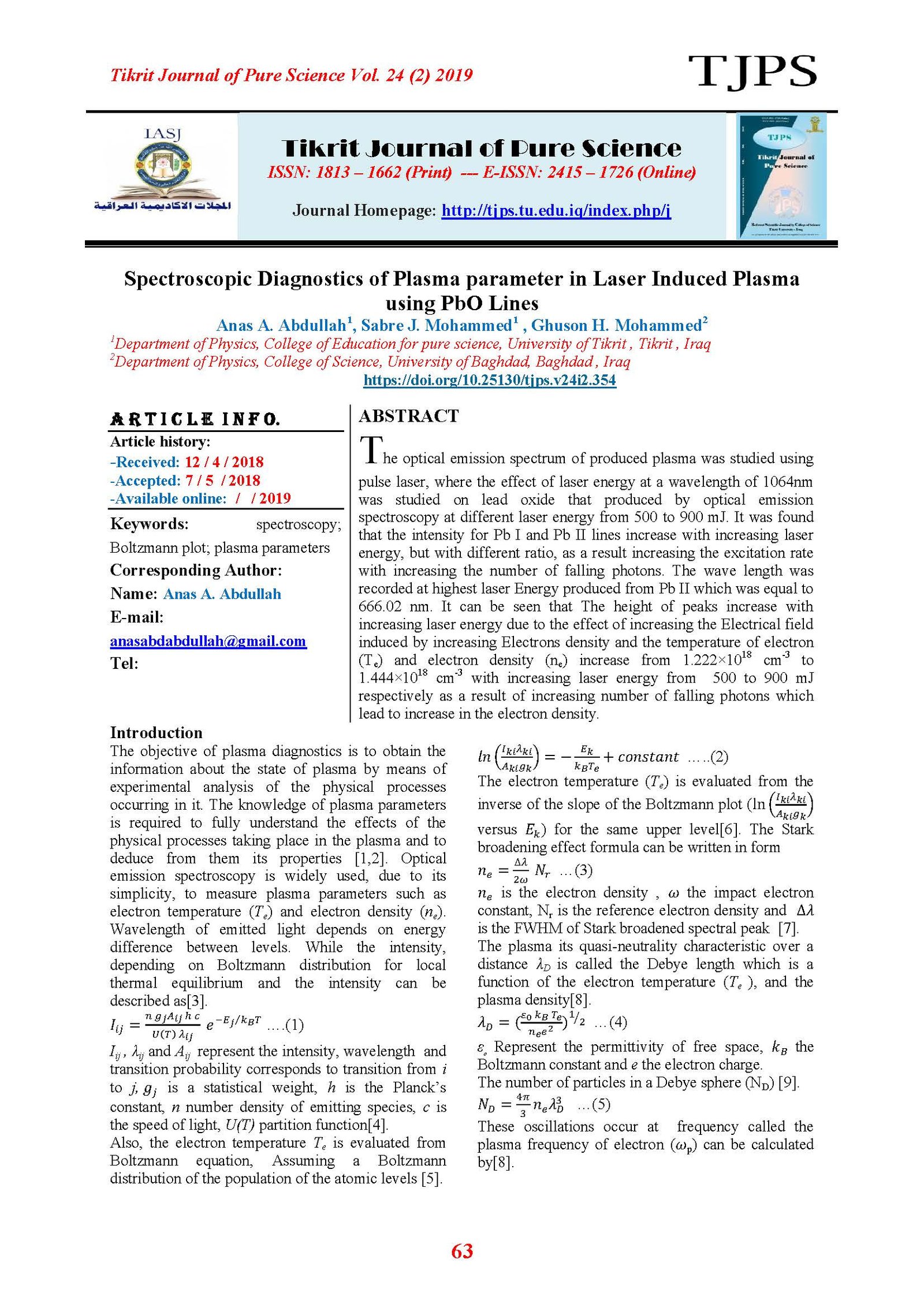Spectroscopic Diagnostics of Plasma parameter in Laser Induced Plasma using PbO Lines
Main Article Content
Abstract
The optical emission spectrum of produced plasma was studied using pulse laser, where the effect of laser energy at a wavelength of 1064nm was studied on lead oxide that produced by optical emission spectroscopy at different laser energy from 500 to 900 mJ. It was found that the intensity for Pb I and Pb II lines increase with increasing laser energy, but with different ratio, as a result increasing the excitation rate with increasing the number of falling photons. The wave length was recorded at highest laser Energy produced from Pb II which was equal to 666.02 nm. It can be seen that The height of peaks increase with increasing laser energy due to the effect of increasing the Electrical field induced by increasing Electrons density and the temperature of electron (Te) and electron density (ne) increase from 1.222×1018 cm-3 to 1.444×1018 cm-3 with increasing laser energy from 500 to 900 mJ respectively as a result of increasing number of falling photons which lead to increase in the electron density.
Article Details

This work is licensed under a Creative Commons Attribution 4.0 International License.
Tikrit Journal of Pure Science is licensed under the Creative Commons Attribution 4.0 International License, which allows users to copy, create extracts, abstracts, and new works from the article, alter and revise the article, and make commercial use of the article (including reuse and/or resale of the article by commercial entities), provided the user gives appropriate credit (with a link to the formal publication through the relevant DOI), provides a link to the license, indicates if changes were made, and the licensor is not represented as endorsing the use made of the work. The authors hold the copyright for their published work on the Tikrit J. Pure Sci. website, while Tikrit J. Pure Sci. is responsible for appreciate citation of their work, which is released under CC-BY-4.0, enabling the unrestricted use, distribution, and reproduction of an article in any medium, provided that the original work is properly cited.
References
[1] Griem, H.R. (1997). Principles of Plasma Spectroscopy, Cambridge, New York.
[2] Tijerina, E.P.; Bohigas, J. and Machorro, R. (2001). Appl. Phys. (90): 3192.
[3] Capitelli, M.; Colonna, G.; Ammando, G.D. and Pietanza, L.D. (2014). Physical Processes in Optical Emission Spectroscopy, in Laser-Induced Breakdown Spectroscopy, Berlin Heidelberg:Springer Series in Optical Scinces, Ch2.
[4] Unnikrishnan, V. et al. (2010). Measurements of plasma temperature and electron density in laser-induced Copper plasma by time-resolved spectroscopy of neutral atom and ion emissions, Pramana - Journal Phys., (74): 983–993.
[5] Mohmoud, A.; Sherbini, E.; Aziz, A. and Alaamer, S. (2002). Measurement of Plasma Parameters in Laser-Induced Breakdown Spectroscopy Using Si-Lines, World Journal Nano Sci. Eng., (2): 206–212.
[6] Inan U. and Golkowski, M. (2011). Principles of Plasma Physics for Engineers and Scientists, New York, Cambridge University Press, Ch1.
[7] Young, J. and Park, H. (2010). Measurement of electron temperature and density using Stark broadening of the coaxial focused plasma for extreme ultraviolet lithography. IEEE Transactions on Plasma Science, 38(5): 1111- 1117.
[8] Chen, F. (1974). Introduction to Plasma Physics and Controlled Fusion, 2nd Edn. New York: Plenum Press, springer,Ch1.
[9] Boyd, T. and Sanderson, J.J. (2003). The Physics of Plasmas, United state, New York: Cambridge University Press, p.465. [10] Sansonetti, J.E. and Martin, W.C. (2005). Handbook of Basic Atomic Spectroscopic Data, Am. Inst. Phys., 34(4).
[11] Mohmoud, A.; Sherbini, E.; Aziz, A. and Al, S. (2012). Measurement of Plasma Parameters in Laser-Induced Breakdown Spectroscopy Using Si-Lines, World Journal Nano Sci. Eng., (2): 206–212.
[12] Lesage, A. (2002). Experimental Stark Widths and Shifts for Spectral Lines of Neutral and Ionized Atoms, 31(3).
[13]Hall, F. and Hill, B. (2000). Introduction to gas discharges, Plasma Sources Sci. Technol., (9): 517–527. [14]Hassouba, M. and Dawood, N. (2014). A Comparative Spectroscopic Study on Emission Characteristics of DC and RF Discharges Plasma using Different Gases, Life Science Journal, 11(9): 656–666.
